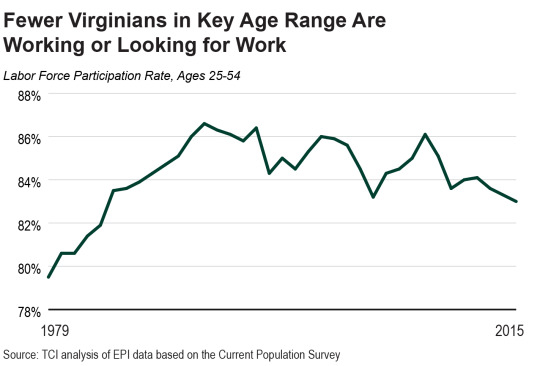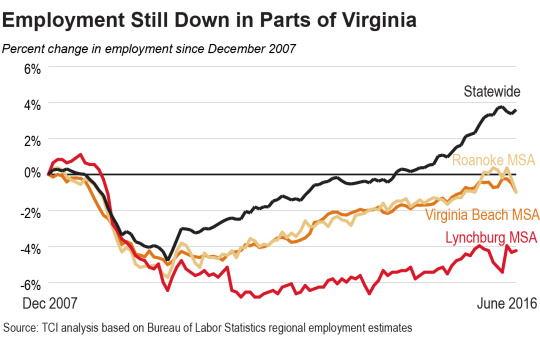July 29, 2016
Unemployment Ticks Down, But Labor Force Shrinks
Within the good news that Virginia’s unemployment rate is the lowest in eight years is the not-so-great news that one reason for the drop is that Virginia’s labor force has shrunk a bit.
Unemployment fell below 4 percent for the past three months. That’s the first time it’s been that low since the middle of 2008, and is a slight improvement from the first three months of 2016, when unemployment averaged 4.1 percent in Virginia. (At TCI, we look at unemployment rates averaged over three months to smooth the significant month-to-month fluctuations in the numbers.) It would be heartening if the falling unemployment rate was solely due to a robust expansion in the number of jobs in Virginia. In fact, nonfarm employment in Virginia has actually shrunk slightly compared to the beginning of 2016. That reduces the official unemployment rate since people who are not looking for work are not counted as unemployed.
It’s too early to know what is causing the slight shrinking of Virginia’s labor force in the last few months. It could be a temporary blip. Or it could be caused by some underlying factor, such as more working-age people moving to another state than moving to Virginia, or more Virginia baby boomers retiring than Virginia millennials entering the labor force, or maybe fewer working-age Virginians working or looking for work. And it’s possible that some combination of all these factors is involved. As of 2015, the share of Virginians between the ages of 25 and 54 who were working or looking for work was at the lowest level since 1983. While this percentage has fluctuated over time, it’s still a concerning trend.

Taking the wider view, of course, Virginia has over 250,000 more jobs than at the depth of the recession in 2009 and 134,000 more than before the recession began. That is a major journey in the right direction. As TCI reported earlier this year, many of those jobs are in Virginia’s critical professional and business services industry and the education and health services industry, while employment is lagging in the construction and manufacturing sectors. And the number of public servants employed by Virginia’s state and local governments is lower than seven years ago, despite the number of Virginia residents growing by over 450,000 from 2009 to 2015.
Not all areas of Virginia have recovered to pre-recession jobs levels. The Lynchburg, Roanoke, and Hampton Roads metro areas still have fewer jobs than in late 2007, as do the areas of Virginia that are not in any metro region.

It’s important to recognize these troubled job sectors and regions of Virginia – and develop solutions to address the structural problems they face – even as we celebrate progress in adding jobs and reducing the state’s unemployment rate.
Virginians worked together to build the strong, modern economy we enjoy today. By investing in excellent public schools and universities, building and improving a world-class port, and moving toward the ideal that everyone who works hard can succeed, Virginia has nurtured, attracted, and maintained world-class talent and businesses. To keep making progress, and make sure no one and no area is left behind, there’s more that can and should be done to invest in the fundamentals of a strong economy.
–Laura Goren, Research Director
Category:
Economic Opportunity
